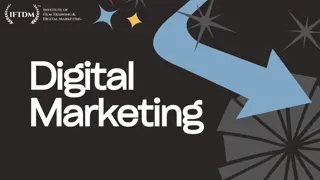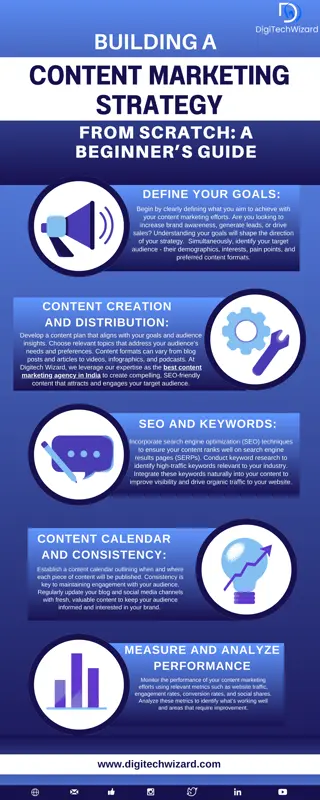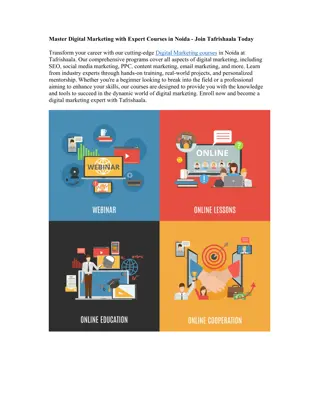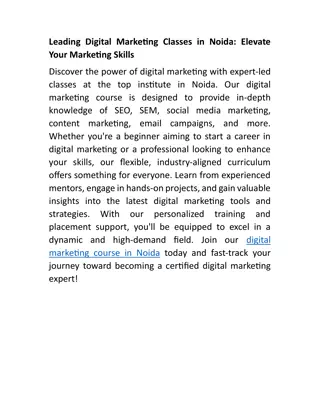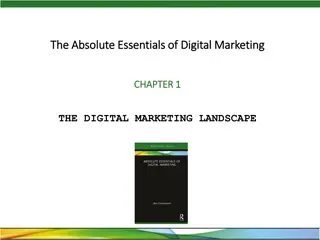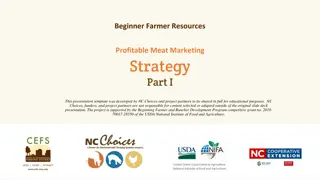Strategic Marketing Essentials and Techniques
Strategic marketing involves analyzing customer needs, managing costs, and understanding competition to create value effectively in a crowded marketplace. By implementing the 3 Cs (Customers, Costs, Competition) and 4 Ps (Product, Price, Place, Promotion) framework, businesses can develop targeted marketing strategies, differentiate from competitors, and maximize profitability through efficient resource allocation and market intelligence.
Download Presentation

Please find below an Image/Link to download the presentation.
The content on the website is provided AS IS for your information and personal use only. It may not be sold, licensed, or shared on other websites without obtaining consent from the author.If you encounter any issues during the download, it is possible that the publisher has removed the file from their server.
You are allowed to download the files provided on this website for personal or commercial use, subject to the condition that they are used lawfully. All files are the property of their respective owners.
The content on the website is provided AS IS for your information and personal use only. It may not be sold, licensed, or shared on other websites without obtaining consent from the author.
E N D
Presentation Transcript
Target marketing defined Customer value proposition Three Cs of marketing Customers, costs, and competition Four Ps of marketing Product, price, place, and promotion Food tourism and tourist types Western food tourists Tourism promotion options and resources
Marketing is anticipating the needs and wants of targeted customers and managing the process through which these needs and wants are satisfied ... profitably
Mass Marketing Commodities Low cost due to economies of scale Low contribution high volume Target Marketing Customer segments Increase value for small segment
The market place can be crowded can you stand out in a crowd?
Strategic Marketing Encompasses the entire firm strategy Deals with the broader issue of determining firm s strategic position in the market and how to create value from that position Product Marketing/Pricing Deals with the tactical side of selling a product Similar to a set of standard operating procedures for marketing a particular product
Analyze strengths, weaknesses, opportunities and threats (SWOT) Use internal and external information Research customers, costs and competition (3 Cs) Develop the marketing mix using product, price, place and promotion (4 Ps)
1. Customer 2. Costs 3. Competition
Who are you selling to? What is important to targeted customers? Make sure you are distinctively different from competition in areas of importance to target customers Competitive analysis Reallocation of resources if necessary Positioning Market intelligence
Loyal are return customers less worried about costs, want a relationship Value segment are hardest to keep happy, but do recognize and value quality Convenience segment are those you can get to make impulse buys less price sensitive Price segment is not too attractive unless you compete entirely on price
For each target segment define Demographics Age, location, education, etc. Psychographics Health, food safety, nutrition, environmental, support local growers, etc. Needs/Preferences Product characteristics, variety, delivery location, etc.
For each target segment estimate Potential number of customers Ex. Number of households within 50 miles Volume of sales per customer Project volume through consumption stats of USDA, local records, own surveys, etc. Potential total sales volume
Know variable costs of producing your product Realize there are fixed costs that must be paid, whether you produce your product or not Use variable and fixed costs to calculate the break-even point where costs are covered Covered in more detail in upcoming financial lessons Compare break-even with industry standards
Tangible Product benefits (costs) that are easy to measure, features Packaging, taste, size . Intangible Product benefits that are not easily measured Local, organic, humanely raised Benefits and costs harder to determine Promotion will often be used to communicate intangible values
To survive in a competitive market-based economic system, You must be a low cost producer Or market to a specialized segment Always know and control your costs You control only what you can quantify and measure You measure costs through accounting and budgeting
From SWOT analysis, assess your business strengths and weaknesses compared to your competitor s Competition can be other operations, regions, product or service types Responses to risks and barriers in the market
Make sure you are distinctively different from your competition in areas of importance to your customers Competitive analysis Reallocation of resources if necessary Positioning
You are concerned with their product position, brand strength and prices Emulating their good ideas may be a key to success Look online, food-oriented publications Read or watch shows you might not otherwise
Price Product Promotion Place
The 4 Ps of Marketing Understanding important Product Claims What Place will Consumer Find You? How will you Promote Cost Effectively? What are Effective Pricing Strategies?
Goods that satisfy the needs of a target market should have the following characteristics: Physical features (design and packaging) Branding and image/personality Degree of customer service: products and services Consistent quality, supply or experience
Grass or Livestock ? Meat or an Experience?
Begin with the end in mind What attributes are important to your market segment? Do your products meet those specifications? Value-added characteristics Traceability, treatments, welfare, certification, local
Set prices based on: Value-based pricing Match price to perceived value by customer, brand loyalty, customer oriented price Competition-based pricing Match prices to similar products of your competition) Cost-based pricing Set price dependent upon production costs) Use discounts or incentives to boost sales but with a specific goal in mind
Price Niche Markets P Specialized Markets n Ps Commercial Markets Pc Demand Quantity Qs Qn Qc
Loyal and Convenience consumers can be highest revenue potential skimming Artisanal, foodies or ready-to-eat products First time buyers may be attracted through penetration Sampling in new market with coupons Volume discounts, CSAs Good pricing strategies can help increase revenues from those less price sensitive High-end meat cuts, heirloom produce, early season crops
Strategic elements of location Do customers translate where you sell into part of your identity? Where does your target market shop? Channels include: Direct sales and internet sales Intermediate sales - broker or distributor Restaurants and grocery
Stimulate sales Differentiate product offerings in varying markets Share information Accentuate value of product Stabilize seasonal demand Source: Lou Pelton, David Strutton, & James Lumpkin. 1997. Marketing Channels: A Relationship Management Approach, pp 99-109.
Advertising Newspaper, television, magazine, radio, Internet, billboard How does Internet change your strategy? Public relations Community service or events Sales promotions Point-of-purchase displays, trade shows, and demonstrations (free samples) Word of mouth Includes social media (Facebook, Twitter) Source: Lou Pelton, David Strutton, & James Lumpkin. 1997. Marketing Channels: A Relationship Management Approach. Pages 99-109.
3 Cs allows you to complete an external assessment of where you fit in the market 4 Ps are strategic choices about how to gain competitive advantage More on positioning and promotion in the Direct Marketing section
Some tourists treat food consumption as part of the travel experience Some tourists use food as a basis for their activities Some tourists use food to select the destination itself Food choices can be motivated by Cultural experience Interpersonal relations Excitement Sensory appeal Health concerns
A foodie is a person with a long-standing passion for eating and learning about food, but are not food professionals May choose to travel specifically to experience new foods Well educated on food, but often just an interest and enthusiasm for learning about food Often have high standards for food quality, but may not require expensive or gourmet foods Frequent food related festivals and events Motivation to visit, stay at accommodations, and eat at local restaurants
Foodie Type Whole-Foodier Than Thou Description Uses only organic methods growing their own produce and flowers, slaughters their own meat, uses simple ingredients in their cooking. Squalor Scholar Cook Does their research and knows the history of their favorite foods and recipes, sticks to traditional recipes, has the academic and historical knowledge of food to set them apart from others. Made in Paris Starts off learning basic cooking techniques in small restaurants and manages to move themselves up the ranks through their connections to make a living cooking in Paris, a foodie mecca. Ultimate upscale foodie that spends much of their time in expensive restaurants, subscribes to important food magazines, and is extremely picky. Paris C est un Dump Gorgeous East in Me Drawn to ethnic and foreign foods, constantly wants to try new things and experience new cultures through food. Regards food as artistic material, aims to impress by creating ice sculptures, elaborately decorated cakes, or butter statues. Small-town foodie that searches out local food and ingredients that deserve attention, constantly attempts to improve their crops and create new dishes. Foodies on Ice All-American
Colorado Agritourism Study 895 survey responses 2005-2006 Age - 46 years on average Income - 37% earned incomes over $75,000 per year Marital status - 73% of travelers were married Family composition - 28% were young couples, no children 42% were families with children 90% identified themselves as White Grouped respondents into five tourist types
Group 1: The Loyal Colorado Enthusiasts - 13% of travelers Parents of older children and couples who return often based on their previous agritourism experiences Largest share of participants in outdoor recreation on farms and ranches during the summer Likely to camp and stay within a few hundred miles of home Participate in a diverse set of agritourism activities Group 2: Family Ag Adventurers - 17% of travelers Most promising agritourism visitors Plans their travels around specific agritourism outings and participates in unplanned activities several times per year Middle-income, often traveling with children in bigger parties Willing to visit local enterprises and travel long distances to reach a variety of agritourism destinations Travel primarily in summer and fall
Group 3: In-State Explorers - 30% of travelers Coloradans who explore the state by car on short jaunts Don t travel with agritourism activities in mind, but participate in unplanned activities Travel frequently and are from upper-middle income households Many planned to travel in the subsequent year and participate in some agritourism The culinary events in which they currently participate may be the best means to extend their visitation and spending into other agritourism experiences Group 4: The Out-of-State Activity Seekers - 4% of travelers No plans to visits the following year More likely to spend longer trips in hotels, resorts, second-homes or bed and breakfast accommodations Primarily mid- to upper-middle class individuals, traveling in smaller parties (even though they are parents) More likely to engage in agritourism as a secondary or unplanned activity Enjoy participating in numerous outdoor activities, and report some of the highest interest across all agritourism activity groups Travel is spread more evenly across all four seasons, relative to others
Group 5: The Accidental Tourists - 36% of travelers Coming for non-recreational business, educational, or convention activities Not seeking agritourism activities
Larger groups participating in agritourism are more likely to plan their trip itinerary (and include agritourism activities) prior to travel) Groups used local and business websites (not national websites) to plan their holiday Tourists attracted to an area by its natural amenities tend to participate in agritourism activities in these areas Need to link marketing for agritourism enterprises to natural parks, forests and recreation areas, such as representing them in park brochures and at visitor centers Private enterprises should describe the natural aspects of their operations in their marketing materials
Utah Tourism Study In-person survey of tourists in Utah (coming from/going to ID, NV, CO, MT), Summer 2013/Winter 2014 Random sampling technique, 700 surveys completed 12 sites at gateways, national parks, airports, ski areas, convention and visitor centers Create a profile of tourist types What types of people visit (demographics, attitudes, interests, etc.) What is the reason for their visit and who travels with them? What types of experiences and activities do they seek? How important are food related experiences? How do they research and plan their travel? How long do they stay and where do they stay?
68% married 52% male College degree 31%, graduate degree 40% 49% full time employed, 29% retired 84% White, 5% Asian, 4% Hispanic Average income in 2012 $103,000 Average age 50 years Length of stay average of 10.6 days Average party size of 2.9 adults and 1.6 children
Research/booking resource Internet/website 41% Brochure/booklet 10% Recommendation from family/friend 3% Tradition 32% Other 14% Travel reason Business travel 14% Visiting family/friends 5% Visiting national parks 8% Outdoor activities 37% Visiting cultural/heritage sites 21% Special events/festivals 2% Agritourism activities 8%
Organization membership (18%) Slow Food = 10% Dining Club = 11% Coop Grocer = 22% Wine/Beer Club = 27% Cooking Club = 8% CSA = 15% Other = 7% Dietary restrictions Yes 15%
While Traveling At Home Buy locally sourced food: Shop at farmer's markets: Participate in a CSA: Buy organic certified produce: Visit local farms: Cook at home: Try new food items or recipes: Buy food you don't recognize: Eat ethnic foods: Attend beer/wine festivals: Food canning: Beer/wine making: Home gardening: Composting: Recycling: Other: 3.52(1.16) 3.08(1.14) 1.73(1.11) 2.79(1.19) 2.05(1.14) 4.29(0.80) 3.86(0.91) 2.93(1.19) 3.57(1.05) 2.39(1.27) 1.80(1.11) 1.35(0.88) 2.62(1.50) 2.14(1.49) 4.35(1.07) 3.75(1.89) Buy locally sourced food: Shop at farmer's markets: Visit local farms: Spend the night at local farms: Participate in agritourism: Cook at accommodations: Try new food items or recipes: Try local recipes: Buy food items as souvenirs or gifts: Seek out local sourcing restaurants: Attend beer/wine festivals: 2.80(1.19) 2.46(1.16) 1.77(0.95) 1.28(0.65) 1.60(0.88) 2.82(1.31) 3.48(1.06) 3.12(1.19) 2.72(1.13) 2.97(1.23) 2.22(1.28) 3.67(1.33) 2.38(1.77) Rating scale of 1-5 (Never to Always)
Factor 1 DIY Factor 2 Factor 3 Direct Organic Food Experiences Variable Home Garden Canning/Preserving Composting Load Variable 0.664 Try New Foods/Recipes 0.574 Eat Ethnic Foods 0.550 Try New Produce Load Variable 0.653 Shop Farmers' Markets 0.571 Visit Farms 0.524 Buy Organic Produce CSA Member Load 0.581 0.497 0.465 0.455 Factor 4 Factor 5 Beer/Wine Enthusiast Local Cook Variable Wine/Beer Making Wine/Beer Festivals Load Variable 0.475 Recycle 0.436 Cook at Home Buy Local Foods Load 0.418 0.401 0.258
Factor 1 Factor 2 Factor 3 All about the farm All about food experiences All about local foods Variable Farm/Ranch Stays Visit Farms Agritourism Activities Load Variable 0.665 Try New Foods 0.650 Try Local Recipes 0.644 Purchase Food Souvenirs Attend Beer/Wine Festivals Load Variable 0.734 Shop Farmers' Markets 0.722 Purchase Local Foods 0.337 Local Sourcing Restaurants 0.254 Cook Accommodations Load 0.639 0.632 0.377 0.279
Family Vacation - 50% of sample Younger (mid 40s), less educated (in comparison) adults, with children, less likely married. Spend fewer days on vacation and are primarily involved in outdoor recreation on an annual trip. Use multiple sources for trip information and tend to do more cooking, but seek local foods and spend a lot on food. Utah Pilgrimage - 8% of sample Older (mid 50s), married individuals traveling with older child, staying for a month and spending little on food, but seeking some food experiences and involved in food clubs. Visiting heritage sites and family primarily. Information from internet and past experience used in trip planning.
Couples Vacation - 11% of sample Married, highly educated, middle-aged couples (upper 40s), seeking food and drink experiences with high food spending. Traditional annual two week trip, use internet for secondary information, visiting heritage sites and outdoor recreation. More heavily involved in food related activities while traveling and at home. Random Vacation - 25% of sample Older (mid 50s), married, more likely male on a 7 day vacation. Traveling with older child in various activities (outdoor recreation, heritage sites, agritourism). Primarily use the internet for trip information. Food spending lower and not all that involved in food related activities while traveling. They just need to eat!
Overall highly educated, married, seeking outdoor recreation, cultural/heritage sites, and agritourism activities Good potential (20% of sample) Couples Vacation (Foodies with funds) Utah Pilgrimage (Cultural/local foods) Family Vacation should not be overlooked Internet-based promotional programs most useful Quality experience essential repeat visits Link marketing for food tourism to outdoor recreation destinations Promote in park and resort brochures, visitor centers, etc. Describe proximity to primary destinations in all materials Heritage trail and food tourism linkages needed
Brochures, flyers, etc. Leave with hotels, visitor centers, parks, resorts Business website Memberships Chambers of commerce, visitor/convention bureaus, local food organizations, etc. Tourist Information Centers (TIC) can help you to reach customers Know how tourists arrive (major hubs/airports) and what activities they seek Other publications Websites State/regional tourism, local food, trip/vacation booking Tourism publications Local, national, international Heritage/scenic trail maps Attraction publications Parks, resorts, etc.













